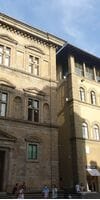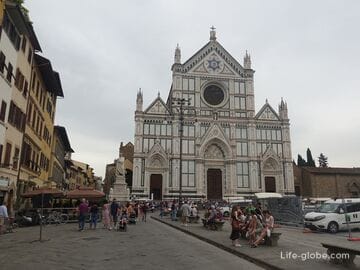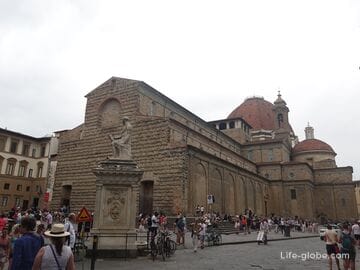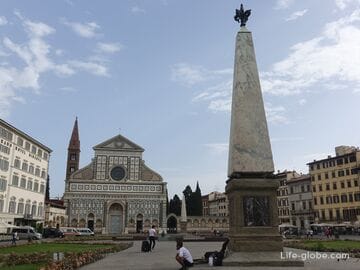Santa Trinita Square, translated from Italian: Holy Trinity Square (Piazza Santa Trinita) is one of the squares in the historical center of Florence, on which an ancient Roman column stands, there is a tower, a church of the same name, Gothic and Renaissance palaces with museums.
The space that now occupies the square was originally located outside the city walls, and after the foundation of the Vallombrosan church and monastery in the 11th century, it was included in the circle in 1172-1275. With the construction of the nearby Santa Trinita Bridge over the Arno River in 1252, the area became an important crossroads of the expanding city.
Until 1911, the square was indicated as part of the Via de' Tornabuoni (Via de' Tornabuoni) crossing it, and after that, thanks to the request of the Marquis Filippo Corsini, the square received its current name Santa Trinita.
During the history of the square - a section of Tornabuoni Street to Palazzo Strozzi, ball-playing competitions were held, which were regularly attended by the Medici. Back then, playing with a ball was a kind of ancestor of tennis or volleyball, but without a racket. The game consisted in hitting a leather ball with a clenched fist on the fly; first it was done with bare hands, and then with a hand inserted into a hollow wooden cylinder (the so-called ball game with a bracelet), which protected the hand and made the blows stronger, but also more dangerous. Often the ball hit the audience, sometimes injuring someone, or in some store near the playing area. Therefore, in order to reduce accidents, in the 18th century the playing field was moved behind the walls.
Today, the Holy Trinity Square is a popular tourist destination in Florence.
The square is located in the historical center of the city, in the fashionable quarter of Florence. It is surrounded by historical buildings, including the Basilica of Santa Trinita of the same name (from which the square got its name), a tower and several palaces.
In the buildings around and near the square there are museums, shops, cafes, restaurants and accommodation facilities (hotels, apartments)
In turn, Tornabuoni Street is one of the main shopping arteries of Florence, boutiques of elite world brands are concentrated on it.


View of the square and Tornabuoni Street from the Santa Trinita Bridge
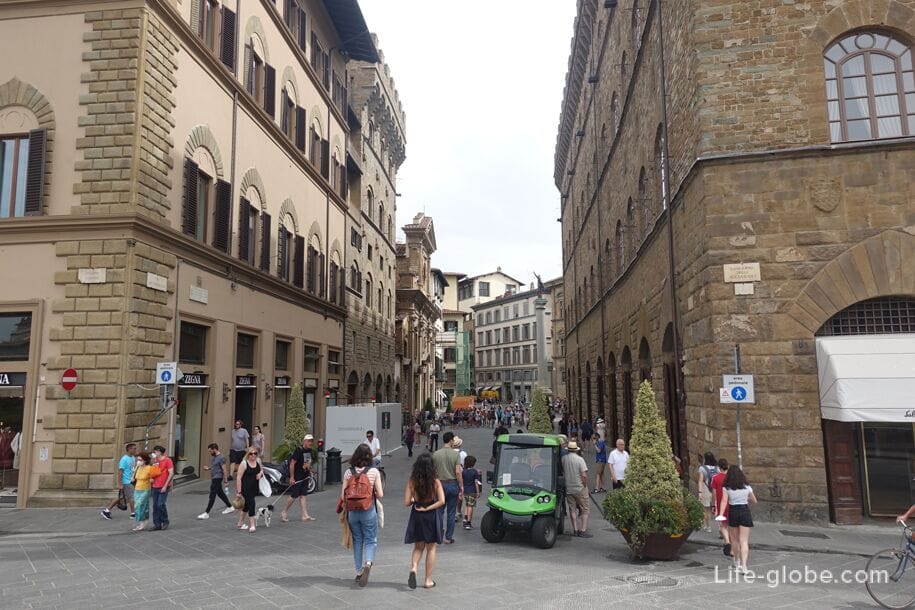
View of the Santa Trinita Bridge from the square
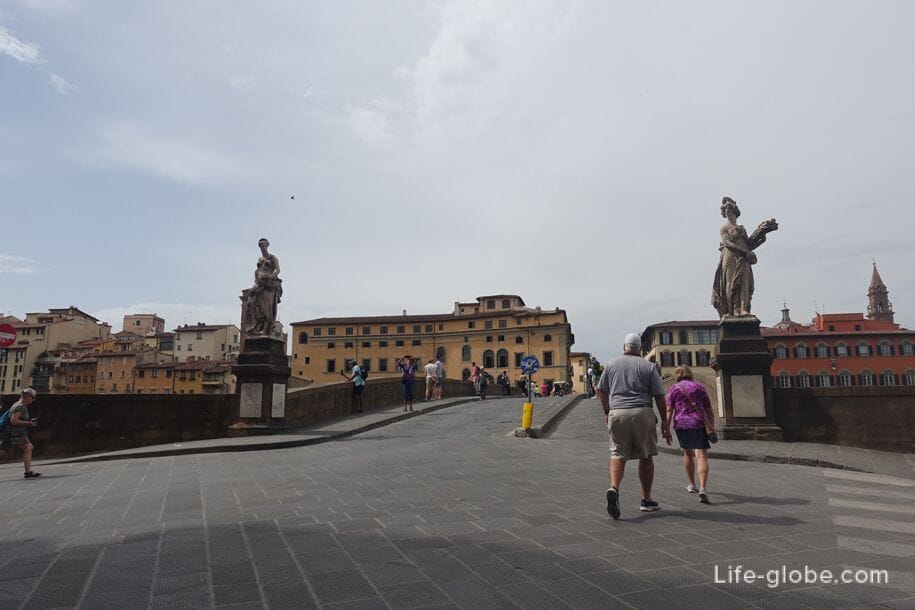
The center of Santa Trinita Square is decorated with an ancient Roman column, known as the Column of Justice (Colonna della Giustizia) because of the sculpture "Justice" on its top.
This monumental column is the tallest among the city columns of Florence. It is made of precious oriental granite (porphyry) and comes from the Baths of Caracalla in Rome.
In 1581, a statue of Justice by the Italian sculptor Francesco del Tadda was added to the top of the column. More about the Column of Justice…
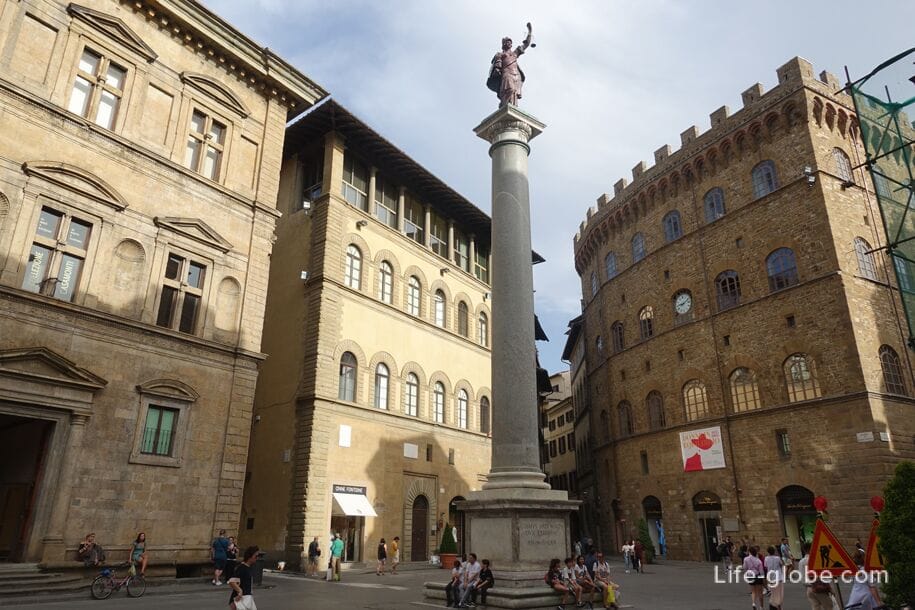
On the western side of the square is the Basilica of Santa Trinita or Basilica of the Holy Trinity (Basilica di Santa Trinita) - a Roman Catholic church with chapels with frescoes of the 15th century, which are considered masterpieces by Italian artists Domenico Ghirlandaio and Lorenzo Monaco.
There is a crypt in the basilica. More about the Basilica of Santa Trinita…

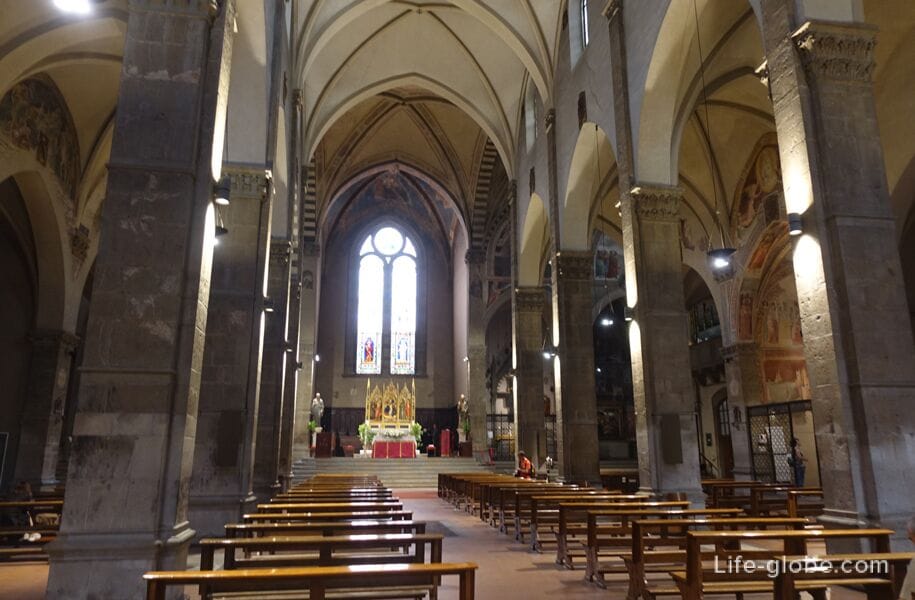
Another dominant feature of the square is the Palazzo Spini Feroni, the building of which is the most monumental on the square and looks even slightly harsh.
This Gothic palace was built in 1289 by the wealthy cloth merchant and banker Geri Spini on plots he bought after the Arno flood in 1288 from the monks of Santa Trinita. At that time it was the largest private palace in Florence, rivaling in size only with the Palazzo Vecchio.
In the 14th century, the palace was divided between two branches of the Spini family. The plot overlooking the square was sold in the 17th century. In the 1670s, the Marquis Francesco Antonio Ferroni, a member of the ruling circle of the Grand Duke Cosimo III, decorated the palace with stucco work by the Italian sculptor Giovan Battista Foggini and Lorenzo Merlini.
In 1846, after a period of staying as a hotel, the palace was bought by the commune of Florence, and then used for government offices in 1865-1871, when Florence was the capital of Italy. In 1874, it was partially renovated in the neo-medieval style; shops were opened on the ground floor, and the tower and arch facing the Arno River and serving to protect the nearby bridge were demolished, which gave the palace its current appearance. In the 1930s, it was bought by shoe designer Salvatore Ferragamo.
Since 1995, the Palazzo has housed the Ferragamo Museum (Salvatore Ferragamo Museum), which is a fashion museum dedicated to the life and work of the Italian shoe designer Salvatore Ferragamo and his company of the same name. The museum's website: ferragamo.com/museo.
Also within the walls of the palace there is a boutique store "Salvatore Ferragamo".
Today Palazzo Spini Feroni remains one of the best examples of medieval residential architecture in Florence, even though its archaic appearance is partly the result of restorations. Also, unlike most Renaissance palaces in Florence, this building retains a solid look of a defensive fort, characteristic of those times when the noble families of Florence had to defend themselves primarily from their own fellow citizens.
Externally, the palace is a stone block, similar to a small fortress, with street arches in the high ground floor, openwork arched windows on subsequent floors, a clock and a protruding cornice topped with battlements in the upper part of the building.
View of the Spini Ferroni Palace from Santa Trinita SquareView of the Spini Ferroni Palace from the Arno River
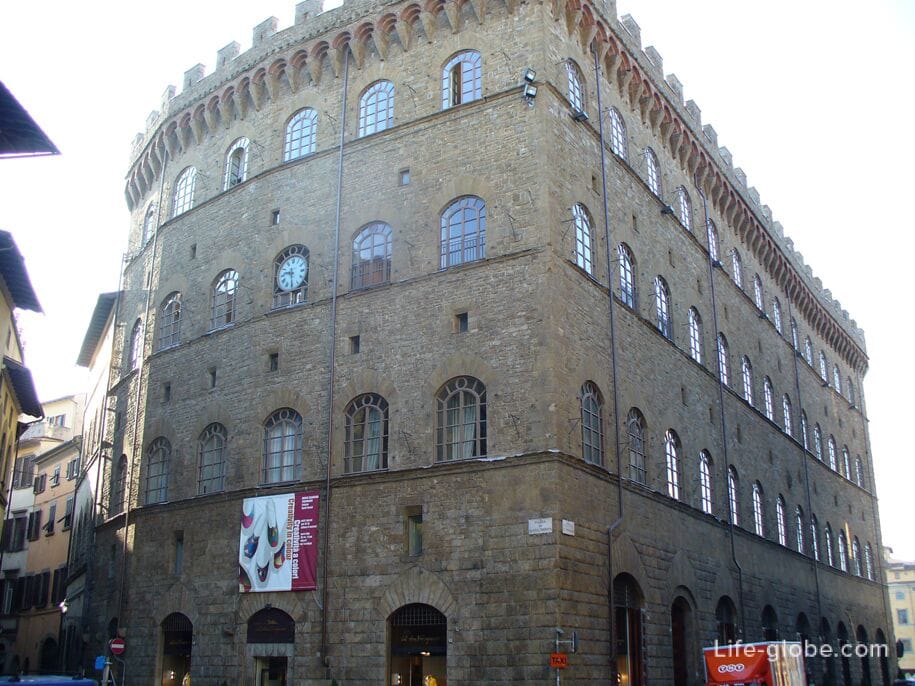
Inside the Spini Ferroni Palace, some frescoes, stucco molding, a vestibule with a coat of arms decoration and a chapel with frescoes by Bernardino Pochchetti from 1609-1612 depicting Paradise with a choir of musical angels in the vault and the Worship of shepherds on the altar are still preserved.
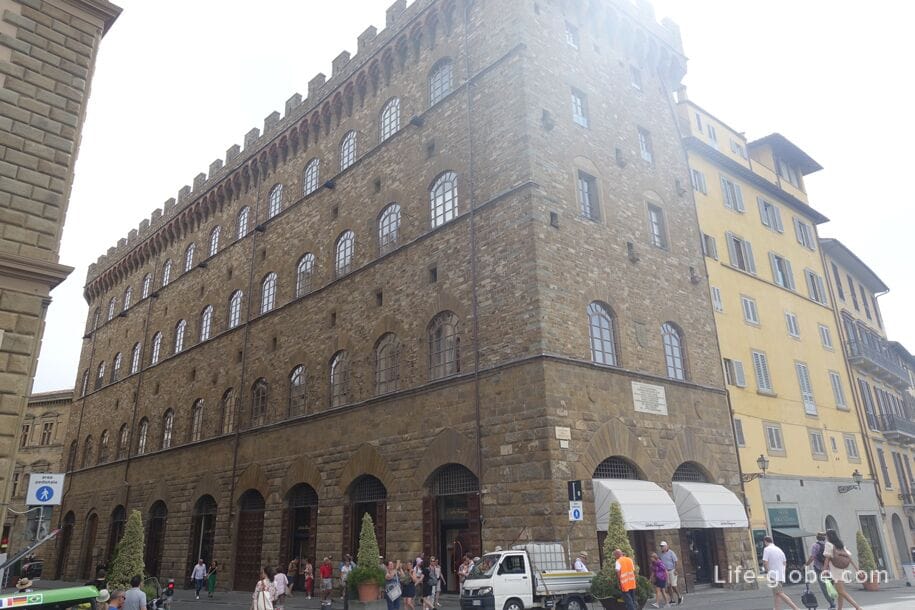
Initially, these frescoes were located in another room of the palace, which served as a chapel, which, during the reconstruction of the eighteenth century, was removed, and in order not to destroy the frescoes, they were separated and moved to a new chapel. The rest of the halls are decorated with frescoes of the 17th and 18th centuries by Ranieri del Pace.
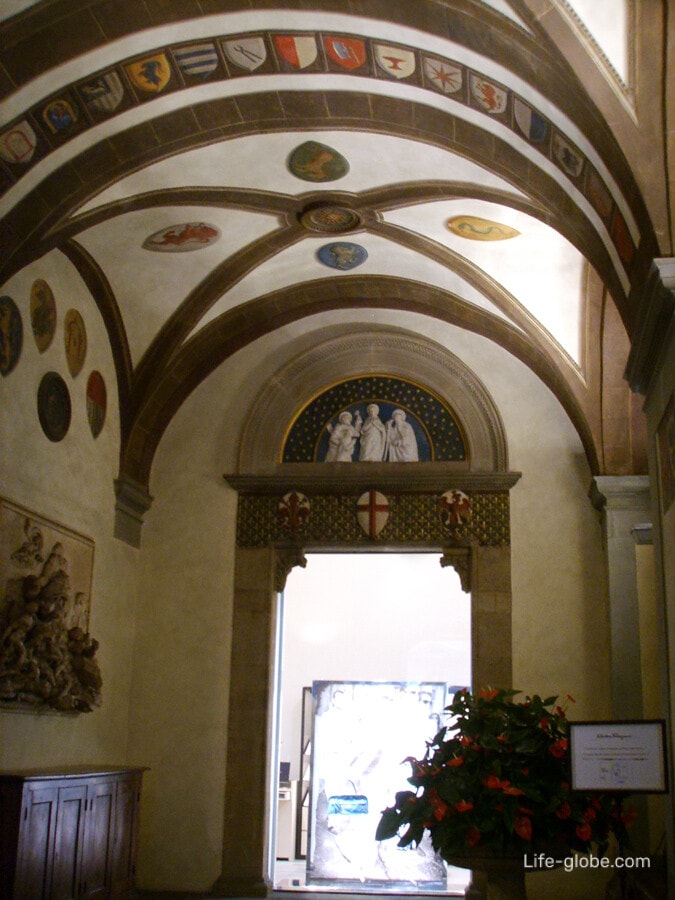
In the underground rooms of the palace there is an old family well, from which residents could draw water without going outside. The well, crowned with a lunette decorated with frescoes with a female profile, is called Pozzo di Beatrice, in honor of Beatrice Portinari, who, as they say, met Dante for the first time in the vicinity of the nearby Santa Trinita Bridge, who transformed her into the image of Beatrice, the muse and inspiration of the poet.
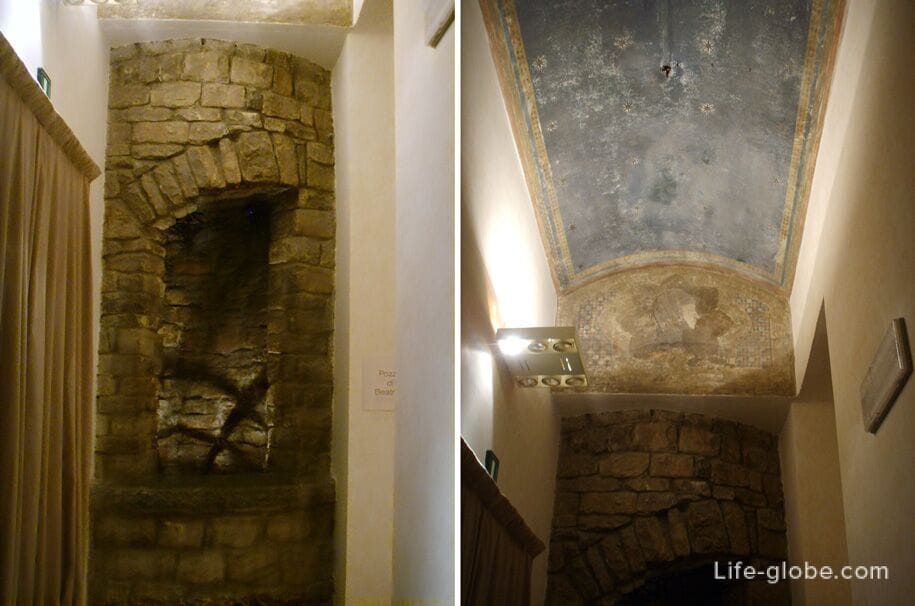
The eastern side of Santa Trinita Square is characterized by two palaces:
- The Palazzo Bartolini Salimbeni (Palazzo Bartolini Salimbeni) of the sixteenth century by the Italian architect Baccio d'Agnolo.
The palace is a masterpiece of the Mannerist style, inspired by the "Roman style" of the sixteenth century, full of ornaments and classical elements in the relief of the columns on the sides of the door, in triangular pediments and in protruding elements that create areas of shadow and light.
The Bartolini-Salimbeni family lived in this building until the beginning of the nineteenth century.
Today, the walls of the palace house the Collection of Roberto Casamonti (Collezione Roberto Casamonti) - a museum exhibition dedicated to contemporary art from the late 19th century to the present day. Website: collezionerobertocasamonti.com;
- Palazzo Buondelmonti or Scali Buondelmonti (Palazzo Buondelmonti, Scali-Buondelmonti) of the sixteenth century.
The palace is a typical Florentine Renaissance residential building, but with more sober forms than the large palaces of this era.
Initially, the Scali houses stood on this site, which passed to the Del Bene family, and then to the Kambi. The building was sold to the Buondelmonti family in 1517, who began its reconstruction, completing the facade around 1525.
The building has a typical three floors plus a roof terrace and two rows of arched windows on seven axes surrounded by simple stone frames. The corners of the building are covered with hewn stone. The first floor is especially high; it is decorated with stone slabs, where four arched openings open, and the upper floors are plastered, although they originally had monochrome graffiti on them.
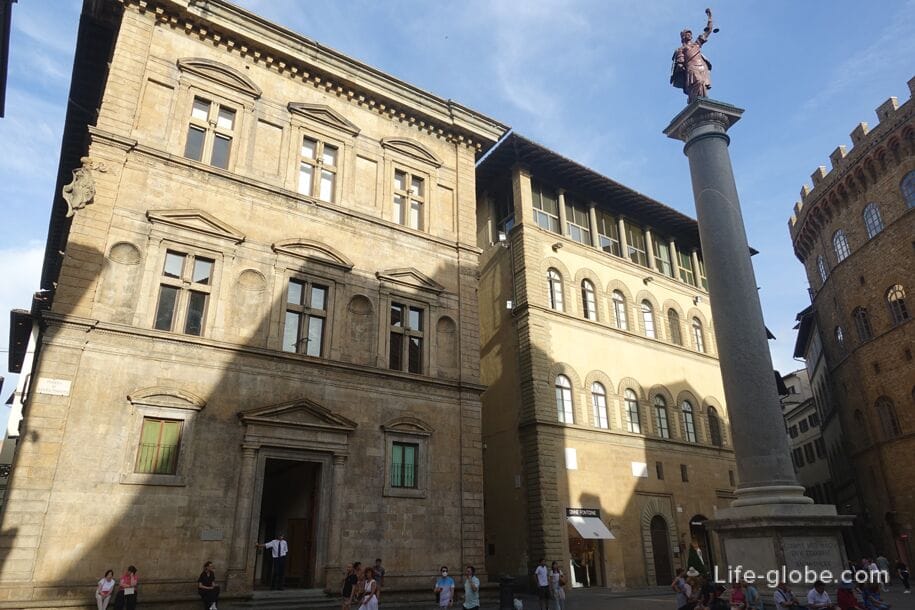
On the south side of the Church of Santa Trinita (towards the Arno River) are:
- the Gianfigliazzi Tower (Torre dei Gianfigliazzi), which looks almost like a palace.
The building was built for the Ruggerini family of Guelphs and was almost completely destroyed after the expulsion of the Guelphs in 1260. The building was then rebuilt and later passed to Fastelli and, at the end of the fourteenth century, to Gianfigliazzi, who remained its owner until the disappearance of the family in 1764.
The building was restored in 1841, when the wedding with loopholes and cornices was rebuilt in imitation of the opposite Palazzo Spini Feroni.
The first floor has arches, then there are rows of windows, and a crenellated balustrade crowns the tower;
- Palazzo Piccioli, which faces the Arno River and originally, like the previous structure, was also part of the Gianfiliazzi family's possessions, and, due to its modest size and proximity to the church of Santa Trinita, was called "Casino di Santa Trinita" (Casino di Santa Trinita).
The current building has the forms of the sixteenth century, and its third floor belongs to the nineteenth-century extension. During the same period, the ground floor was combined with the floor of the neighboring Gianfilhiazzi tower for commercial use, which have survived to this day.
Today there are shops, cafes and a bed and breakfast Antica Torre Di Via Tornabuoni 1 with suites, a restaurant, private parking, free Wi-Fi and a rooftop terrace with panoramic views of the historic center of Florence and the surrounding hills. Link to the hotel
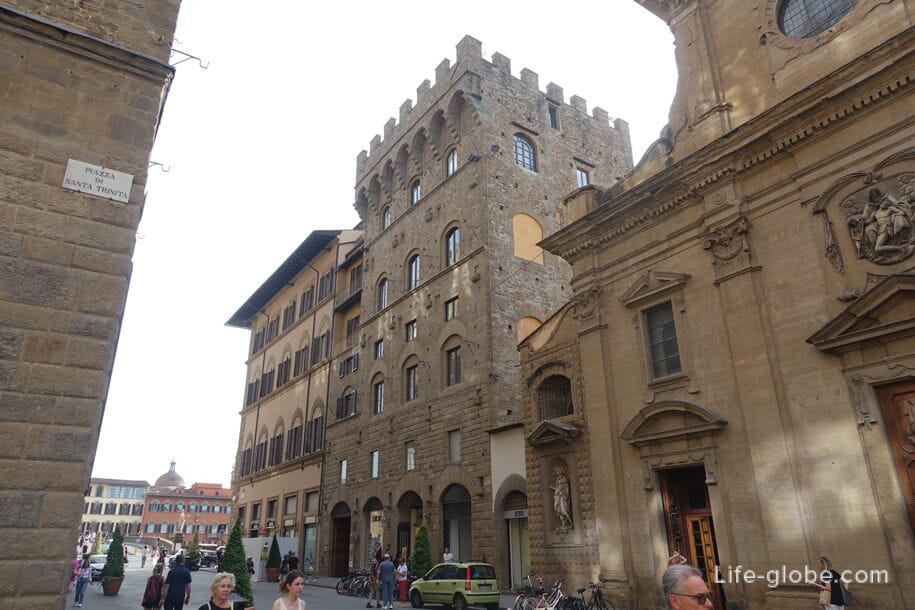
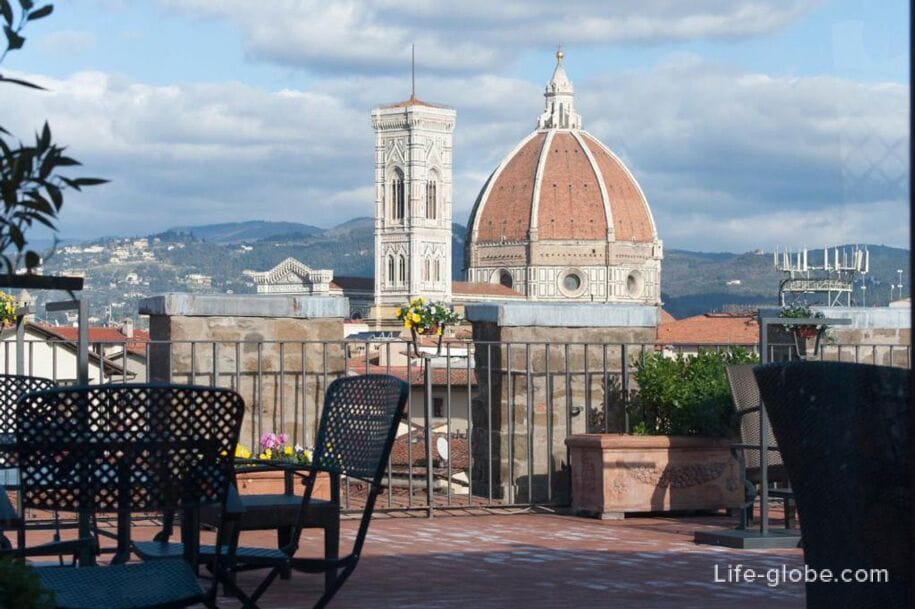
The northeast corner of the square closes the Minerbetti Palace (Palazzo Minerbetti).
The original building dates from the late thirteenth or early fourteenth century, built by the Bombeni family and acquired in the second half of the fifteenth century by the Minerbetti, an ancient family, apparently of English origin, a secondary branch of the Becketts who fled their country after the assassination of Archbishop of Canterbury Thomas A. Becket, who already owned other buildings in this area of Florence.
The building has a corner terrace, which was restored in the 1830s and 1767. In 1761, architect Pier Giovanni Fabbroni built a niche and a private chapel with frescoes decorated by Diacinto Fabbroni, who also painted an altar table depicting the Martyrdom of St. Thomas Beckett.
Today, the building has mainly the style of the late Middle Ages, with a sloping facade of hewn stone, which gives it a solid appearance. The upper floor is a buffer roof terrace. On the corner there is a building that looks like a separate house, but in fact is the same building that has a terrace-balcony with wrought iron railings, as well as the coat of arms of Minerbetti on the corner. It is this extension that gives the whole structure an unusual and slightly playful look.
Today, the palace houses a shop and The 5-star IL Tornabuoni The Unbound Collection by Hyatt features a rooftop terrace with champagne bar and panoramic views of Florence. Room rates may include breakfast. Hotel Link
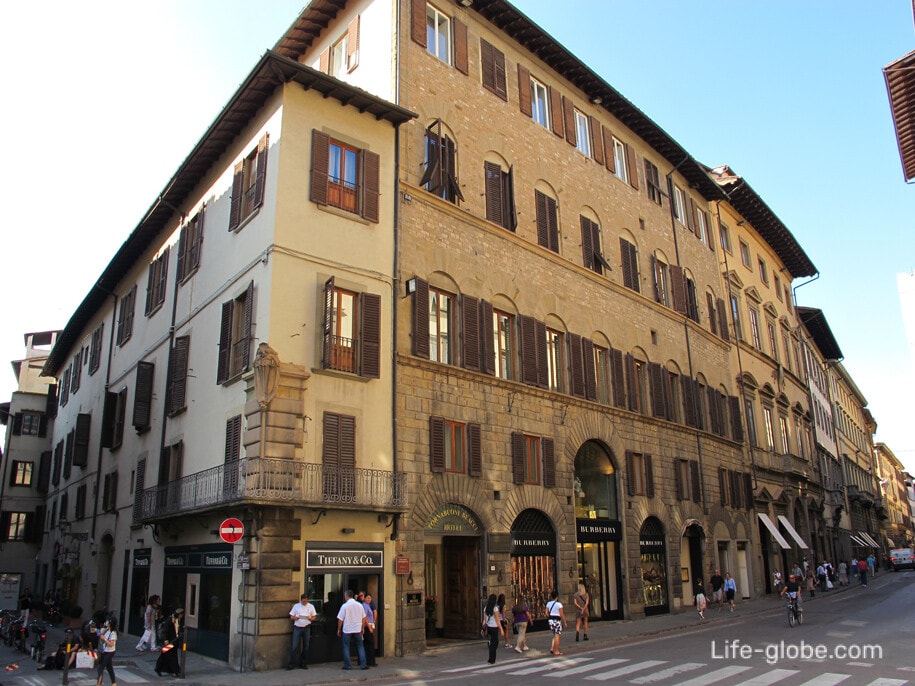

All accommodation facilities in Florence (hotels, apartments, guest houses, etc.), including those in the historic city center, on and near Piazza Santa Trinita, and more remotely from those, can view and book here
Practical information
Santa Trinita Square is open to the public 24 hours a day.
Santa Trinita Square is located in the historic center of Florence, 650 meters from the main square of the city - Duomo Square and 500 meters from the beautiful historic Piazza della Signoria.
Coordinates of Santa Trinita Square: 43°46'12.3"N 11°15'04.5"E (43.770081, 11.251244).




